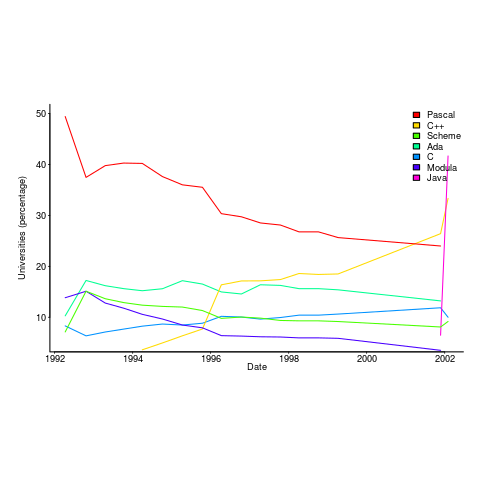Derek Jones from The Shape of Code
Programming do-gooders sometimes fall into the trap of thinking that banning the use of a problematic language construct removes the possibility of the problems associated with that construct’s usage construct from occurring. The do-gooders overlook the fact that developers use language constructs because they solve a coding need, and that banning usage does not make the coding need go away. If a particular usage is banned, then developers have to come up with an alternative to handle their coding need. The alternative selected may have just as many, or more, problems associated with its use as the original usage.
The C++ committee has fallen into this do-gooder trap by deprecating the use of some unary operators (i.e., ++ and --) and compound assignment operators (e.g., += and &=) on objects declared with the volatile type-specifier. The new wording appears in the 2020 version of the C++ Standard; see sections 7.6.1.5, 7.6.2.2, 7.6.19, and 9.6.
Listing a construct as being deprecated gives notice that it might be removed in a future revision of the standard (languages committees tend to accumulate deprecated constructs and rarely actually remove a construct; breaking existing code is very unpopular).
What might be problematic about objects declared with the volatile type-specifier?
By declaring an object with the volatile type-specifier a developer is giving notice that its value can change through unknown mechanisms at any time. For instance, an array may be mapped to the memory location where the incoming bytes from a communications port are stored, or the members of a struct may represent the various status and data information relating to some connected hardware device.
The presence of volatile in an object’s declaration requires that the compiler not optimise away assignments or accesses to said object (because such assignments or accesses can have effects unknown to the compiler).
volatile int k = 0;
int i = k, // value of k not guaranteed to be 0
j = k; // value of k may have changed from that assigned to i
if (i != j)
printf("The value of k changed from %d to %d\n", i, j);
If, at some point in the future, developers cannot rely on code such as k+=3; being supported by the compiler, what are they to do?
Both the C and C++ Standards state:
“The behavior of an expression of the form E1 op = E2 is equivalent to E1 = E1 op E2 except that E1 is evaluated only once.”
So the code k=k+3; cannot be relied upon to have the same effect as k+=3;.
One solution, which does not make use of any deprecated language constructs, is:
volatile int k;
int temp;
/* ... */
temp=k;
temp+=3;
k=temp;
In what world is the above code less problematic than writing k+=3;?
I understand that in the C++ world there are templates, operator overloading, and various other constructs that can make it difficult to predict how many times an object might be accessed. The solution is to specify the appropriate behavior for volatile objects in these situations. Simply deprecating them for some operators is all cost for no benefit.
We can all agree that the use of volatile has costs and benefits. What is WG21’s (the ISO C++ Committee) cost/benefit analysis for deprecating this usage?
The WG21 proposal P1152, “Deprecating volatile”, claims that it “… preserves the useful parts of volatile, and removes the dubious / already broken ones.”
The proposal is essentially a hatchet job, with initial sections written in the style of the heroic fantasy novel The Name of the Wind, where “…kinds of magic are taught in the university as academic disciplines and have daily-life applications…”; cut-and-pasting of text from WG14 (ISO C committee) documents and C++17 adds bulk. Various issues unrelated to the deprecated constructs are discussed, and it looks like more thought is needed in some of these areas.
Section 3.3, “When is volatile useful?”, sets the tone. The first four paragraphs enumerate what volatile is not, before the fifth paragraph admits that “volatile is nonetheless a useful concept to have …” (without listing any reasons for this claim).
How did this deprecation get accepted into the 2020 C++ Standard?
The proposal appeared in October 2018, rather late in the development timeline of a standard published in 2020; were committee members punch drunk by this stage, and willing to wave through what appears to be a minor issue? The document contains 1,662 pages of close text, and deprecation is only giving notice of something that might happen in the future.
Soon after the 2020 Standard was published, the pushback started. Proposal P2327, “De-deprecating volatile compound operations”, noted: “deprecation was not received too well in the embedded community as volatile is commonly used”. However, the authors don’t think that ditching the entire proposal is the solution, instead they propose to just de-deprecate the bitwise compound assignments (i.e., |=, &=, and ^=).
The P2327 proposal contains some construct usage numbers, obtained by grep’ing the headers of three embedded SDKs. Unsurprisingly, there were lots of bitwise compound assignments (all in macros setting various flags).
I used Coccinelle to detect actual operations on volatile objects in the Silabs Gecko SDK C source (one of the SDKs measured in the proposal; semgrep handles C and C++, but does not yet fully handle volatile). The following table shows the number of occurrences of each kind of language construct on a volatile object (code and data):
Construct Occurrences
V++ 83
V-- 5
++V 9
--V 2
bit assign 174
arith assign 27
Will the deprecated volatile usage appear in C++23? Probably, purely because the deadline for change has passed. Given WG21’s stated objective of a 3-year iteration, the debate will have to wait for work on to start on C++26.

